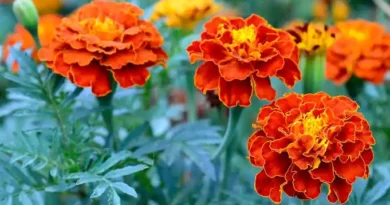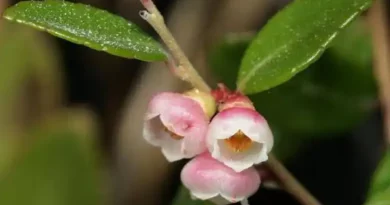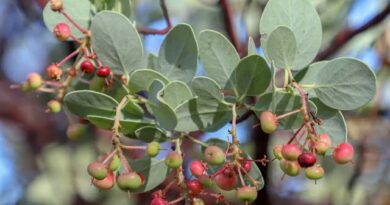17 Medicinal Health Benefits Of Hagenia abyssinica (African Redwood)
Hagenia abyssinica, commonly known as African Redwood, is a remarkable medicinal plant with a rich history of traditional use for various health benefits. This article will discuss the diverse medicinal properties and historical significance of Hagenia abyssinica.
History of Hagenia abyssinica Medicinal Plant Use
1. Traditional African Remedies: For centuries, indigenous communities across Africa have utilized Hagenia abyssinica for its therapeutic properties. This ancient tradition of using African Redwood as a medicinal plant has been passed down through generations.
2. Ethnobotanical Importance: Hagenia abyssinica holds significant ethnobotanical value among various African cultures. It has been an integral part of traditional medicine systems, where it was employed to treat a wide range of ailments.
3. Cultural Significance: The cultural significance of Hagenia abyssinica extends beyond its medicinal use. It is often associated with rituals and ceremonies, symbolizing its importance in the cultural heritage of many African communities.
4. Historical Records: Historical records and ethnographic studies reveal the extensive use of Hagenia abyssinica in treating illnesses, including respiratory disorders, gastrointestinal problems, and skin conditions.
5. Botanical Documentation: European explorers and botanists in the 19th century documented the presence of Hagenia abyssinica in African landscapes, recognizing its medicinal potential.
6. Modern Research: In recent years, scientific research has begun to validate some of the traditional uses of Hagenia abyssinica, shedding light on its potential as a source of natural remedies.
7. Conservation Concerns: Due to its extensive use and habitat destruction, there are concerns about the conservation status of Hagenia abyssinica. Efforts are being made to sustainably manage its populations.
8. Integration into Modern Medicine: With ongoing research and increased awareness, there is growing interest in integrating Hagenia abyssinica into modern healthcare systems, potentially unlocking new medicinal applications.
The Botanical Description of Hagenia abyssinica
1. Life: Hagenia abyssinica is a perennial, evergreen tree.
2. Size: It typically reaches a height of 15-25 meters, with some specimens growing even taller.
3. Leaves: The leaves are pinnate and arranged alternately along the branches. Each leaf consists of several leaflets.
4. Flowers: The flowers are small and clustered in dense, spherical heads. They are typically white to pinkish in color and have a pleasant fragrance.
5. Fruit: The fruit of Hagenia abyssinica is a capsule, which contains small, winged seeds.
6. Bark: The bark of the tree is reddish-brown and often peels in strips.
7. Habitat: This species is native to the highland regions of East Africa, where it thrives in cool, moist environments.
8. Cultural and Ecological Significance: Beyond its botanical characteristics, Hagenia abyssinica plays a crucial role in the ecosystems of its native habitat and continues to be intertwined with the culture and livelihoods of local communities.
The Geographic Distribution of Hagenia abyssinica
1. Native Habitat: Hagenia abyssinica is primarily native to the highland regions of East Africa, including countries such as Ethiopia, Kenya, Tanzania, and Uganda. It thrives in cool, moist environments at elevations ranging from 1,500 to 3,500 meters above sea level.
2. Altitudinal Range: This species exhibits a remarkable altitudinal range, making it well-adapted to various highland ecosystems. It can be found in both montane and subalpine areas.
3. Ecological Niches: Hagenia abyssinica often dominates the tree canopy in its native habitat, contributing to the structure and composition of these ecosystems.
4. Endemic Species: In some regions, it is considered an endemic species, meaning it is found exclusively in specific geographic areas, further emphasizing its significance.
5. Climate Preference: The plant prefers regions with a temperate climate, characterized by moderate temperatures and ample rainfall, making it an important part of the local ecosystems.
6. Biodiversity Hotspots: Some of the regions where Hagenia abyssinica is found are recognized as biodiversity hotspots, underscoring the importance of its role in preserving unique and diverse ecosystems.
7. Conservation Status: Due to habitat destruction and overharvesting, there are conservation concerns regarding the populations of Hagenia abyssinica in its natural habitat. Conservation efforts are being undertaken to protect this species and its ecosystems.
8. Cultural Significance: The geographic distribution of Hagenia abyssinica aligns closely with the regions where it holds cultural significance, further highlighting its importance in the lives of local communities.
The Chemical Composition of Hagenia abyssinica
1. Phytochemicals: Hagenia abyssinica contains a diverse array of phytochemicals, including alkaloids, flavonoids, tannins, and phenolic compounds. These compounds contribute to its medicinal properties.
2. Alkaloids: Some alkaloids found in Hagenia abyssinica have been investigated for their potential pharmacological activities, such as antimalarial and analgesic effects.
3. Flavonoids: Flavonoids in this plant are known for their antioxidant properties, which can help combat oxidative stress and related health issues.
4. Tannins: Tannins are compounds that contribute to the astringent taste of the plant. They have been studied for their potential antimicrobial and anti-inflammatory properties.
5. Phenolic Compounds: Phenolic compounds are associated with various health benefits, including anti-inflammatory and antioxidant effects.
6. Essential Oils: Some chemical constituents in Hagenia abyssinica contribute to its aromatic qualities and may have therapeutic applications.
7. Active Compounds: Ongoing research aims to identify and isolate specific active compounds responsible for the plant’s medicinal properties, potentially leading to the development of new pharmaceuticals.
The Cultivation and Growth of Hagenia abyssinica
1. Climate Requirements: Hagenia abyssinica thrives in regions with a temperate climate. It requires cool temperatures and consistent moisture.
2. Soil Preferences: The plant prefers well-drained, loamy soils with good organic matter content. It is adaptable to different soil types.
3. Altitude Considerations: When cultivating Hagenia abyssinica, altitude plays a crucial role. It is best suited for areas with elevations between 1,500 and 3,500 meters.
4. Seed Propagation: The propagation of Hagenia abyssinica is often done through seeds, which can be collected from mature trees and sown in nurseries.
5. Growth Rate: The growth rate of this tree can vary, but it is generally considered slow to moderate. It may take several years to reach maturity.
6. Pruning and Maintenance: Regular pruning and maintenance are necessary to shape the tree and promote healthy growth.
7. Agroforestry Potential: Hagenia abyssinica has potential in agroforestry systems, where it can provide both timber and medicinal resources while maintaining soil health.
The Harvesting and Processing of Hagenia abyssinica
1. Sustainable Harvesting: Harvesting of Hagenia abyssinica must be done sustainably to ensure the long-term survival of the species. Selective harvesting and minimal damage to the tree are essential.
2. Bark Harvesting: The bark of Hagenia abyssinica is often sought for its medicinal properties. It should be harvested carefully, without girdling the tree, to allow for regeneration.
3. Drying and Storage: After harvesting, the bark and other plant parts are typically dried and stored for later use. Proper drying methods help preserve the medicinal properties.
4. Traditional Processing: In some communities, traditional processing methods involve grinding the bark into a powder or creating extracts for medicinal use.
5. Modern Extraction: Modern extraction techniques, such as solvent extraction, are being explored to obtain specific compounds from Hagenia abyssinica for pharmaceutical applications.
6. Quality Control: Quality control measures are crucial in processing to ensure the final product’s safety and efficacy.
7. Potential Products: Processed Hagenia abyssinica may be used to create various medicinal products, such as tinctures, capsules, or topical preparations.
8. Commercialization: As interest in the plant’s medicinal properties grows, there is potential for commercialization, which must be approached with consideration for sustainability and ethical practices.
9. Cultural Traditions: In some cultures, the harvesting and processing of Hagenia abyssinica remain deeply rooted in traditional practices and rituals, emphasizing its cultural significance.
Read Also: 18 Medicinal Health Benefits Of Funtumia elastica (African Rubber Tree)
The Medicinal Health Benefits Of Hagenia abyssinica (African Redwood)

1. Respiratory Health: Hagenia abyssinica has been traditionally used to alleviate respiratory ailments, including coughs, bronchitis, and asthma, thanks to its bronchodilatory and expectorant properties.
2. Anti-Inflammatory Effects: Compounds in African Redwood exhibit anti-inflammatory properties, making it beneficial for conditions like arthritis and inflammatory skin disorders.
3. Gastrointestinal Health: Hagenia abyssinica may aid digestion and relieve gastrointestinal discomfort, such as indigestion and bloating.
4. Antibacterial Properties: It has shown antibacterial activity against various pathogens, suggesting its potential in treating infections.
5. Antioxidant Action: The plant’s antioxidants can help combat oxidative stress and protect cells from damage.
6. Pain Relief: Traditional use includes pain relief, making it valuable for conditions like headaches and menstrual cramps.
7. Antimalarial Activity: Some compounds in Hagenia abyssinica have demonstrated antimalarial properties in scientific studies.
8. Skin Health: It is used topically to soothe skin irritations, rashes, and wounds.
9. Fever Reduction: The plant has been employed to reduce fever, particularly in traditional African medicine.
10. Wound Healing: Hagenia abyssinica may facilitate wound healing due to its antimicrobial and anti-inflammatory effects.
11. Stomach Ulcer Management: Traditional remedies suggest its potential for managing stomach ulcers.
12. Immune Support: Compounds in the plant may support the immune system, aiding in overall health.
13. Antifungal Properties: It has shown antifungal activity against certain fungal infections.
14. Cardiovascular Health: Some studies suggest a role in improving heart health by reducing blood pressure and cholesterol levels.
15. Liver Health: Traditional use includes liver support and detoxification.
16. Antispasmodic Effects: It may help relieve muscle spasms and cramps.
17. Anti-Anxiety and Relaxation: In some cultures, it is used to promote relaxation and reduce anxiety.
Methods of Usage to Achieve the Provided Health Benefits Of Hagenia abyssinica (African Redwood)
1. Oral Infusion: Prepare a tea or infusion from the leaves or bark to address various health issues.
2. Decoction: Boil plant parts to make a concentrated solution for more potent effects.
3. Topical Application: Apply crushed leaves or bark directly to the skin for wound healing and skin conditions.
4. Steam Inhalation: Inhale steam from a decoction for respiratory relief.
5. Tinctures: Create alcohol-based tinctures for easy dosage and long shelf life.
6. Powdered Form: Crush dried plant parts into a powder for oral consumption or external use.
7. Capsules: Fill capsules with powdered Hagenia abyssinica for convenient dosing.
8. Ointments: Combine plant extracts with a base to make ointments for skin issues.
9. Poultices: Apply a poultice of crushed plant material to wounds or inflamed areas.
10. Compresses: Soak cloth in a prepared solution and apply as a compress.
11. Baths: Add plant extracts to baths for skin and relaxation benefits.
12. Ingestible Oils: Infuse plant material into oils for culinary or medicinal use.
13. Gargles and Mouthwashes: Use infusions or decoctions for oral hygiene and throat health.
14. Steam Baths: Create herbal steam baths for respiratory and skin benefits.
15. Smudging: Burn dried Hagenia abyssinica as incense for spiritual and cleansing purposes.
16. Syrups: Make syrup from plant extracts for cough and sore throat relief.
17. Lotions: Blend plant extracts with a lotion base for skin care.
Side effects of Using Hagenia abyssinica Medicinal Plant
1. Gastrointestinal Upset: Some individuals may experience gastrointestinal discomfort, including nausea, vomiting, or diarrhea, when using Hagenia abyssinica.
2. Allergic Reactions: Allergic reactions, such as skin rashes or itching, can occur in sensitive individuals when exposed to Hagenia abyssinica or its derivatives.
3. Headaches: Headaches may develop as a side effect of Hagenia abyssinica use in some cases.
4. Dizziness: Some individuals may feel dizzy or lightheaded when using products containing Hagenia abyssinica.
5. Blood Pressure Changes: Hagenia abyssinica may have an impact on blood pressure, potentially leading to changes in blood pressure levels.
6. Liver Health: Excessive or prolonged use of Hagenia abyssinica may have implications for liver health, so it should be used cautiously.
7. Interactions with Medications: Hagenia abyssinica may interact with certain medications, affecting their efficacy or causing adverse effects. It’s essential to consult a healthcare professional before using it alongside other medications.
Read Also: Everything You Need To Know About Spice of Life
Safety Precautions and Recommendations In Using Hagenia abyssinica Medicinal Plant

1. Dosage Guidance: Always follow recommended dosages when using Hagenia abyssinica. Overconsumption can lead to adverse effects.
2. Allergic Reactions: Be aware of potential allergies to any part of the plant. If you experience allergic reactions, discontinue use and seek medical attention.
3. Consultation with Healthcare Provider: If you have pre-existing medical conditions or are taking medications, consult a healthcare provider before using Hagenia abyssinica for medicinal purposes.
4. Pregnancy and Breastfeeding: Pregnant and breastfeeding individuals should exercise caution and seek medical advice before using this plant, as its safety in these situations is not well-established.
5. Interactions with Medications: Some compounds in Hagenia abyssinica may interact with medications. Check for potential interactions with your current medications.
6. Sustainable Harvesting: If you plan to harvest the plant yourself, do so sustainably, and avoid harming the plant or its habitat. Follow local regulations and guidelines.
Legal Status and Regulations In Using Hagenia abyssinica Medicinal Plant
1. Protected Species: In some regions, Hagenia abyssinica may be protected due to its ecological importance. Ensure compliance with local laws and regulations regarding its harvesting and use.
2. Conservation Concerns: Due to habitat destruction and overharvesting, there may be regulations in place to protect this species. Follow guidelines for sustainable use and conservation efforts.
3. Traditional Medicine Laws: In areas where traditional medicine is practiced, there may be regulations governing the use of medicinal plants like Hagenia abyssinica. Familiarize yourself with these regulations.
4. Export Restrictions: If you plan to export or trade in Hagenia abyssinica or its products, research international regulations and obtain the necessary permits.
5. Intellectual Property Rights: If you intend to commercialize products derived from Hagenia abyssinica, be aware of intellectual property rights and patent issues related to its use.
6. Quality Control: When producing and selling products containing Hagenia abyssinica, ensure compliance with quality control and labeling regulations to provide safe and accurately labeled products to consumers.
FAQs About Hagenia abyssinica Medicinal Plant
1. Is Hagenia abyssinica safe for consumption?
Hagenia abyssinica can be safe when used appropriately, but excessive consumption may lead to side effects. Follow recommended dosages.
2. Can I use Hagenia abyssinica during pregnancy?
Pregnant individuals should exercise caution and consult a healthcare provider before using Hagenia abyssinica, as its safety during pregnancy is not well-established.
3. Are there any known drug interactions with Hagenia abyssinica?
Some compounds in Hagenia abyssinica may interact with medications. Consult a healthcare provider if you are taking prescription drugs.
4. How should I store Hagenia abyssinica products?
Store products in a cool, dry place away from direct sunlight to maintain their quality and efficacy.
5. Can I harvest Hagenia abyssinica myself?
If harvesting, do so sustainably and follow local regulations. Avoid damaging the plant or its habitat.
6. Is Hagenia abyssinica legally protected in some regions?
Yes, it may be protected due to conservation concerns. Familiarize yourself with local laws and regulations regarding its use.
7. What are the common side effects of using Hagenia abyssinica?
Common side effects may include gastrointestinal discomfort, allergic reactions, and skin irritation.
8. Can I use Hagenia abyssinica for children?
Consult a healthcare provider before administering Hagenia abyssinica to children, as dosage and safety considerations may differ.
9. How can I identify Hagenia abyssinica in the wild?
Seek guidance from experts or use botanical identification resources to ensure you are harvesting the correct plant.
10. Are there any restrictions on exporting Hagenia abyssinica products internationally?
Research international regulations and obtain necessary permits if you plan to export or trade in Hagenia abyssinica or its products.
11. Can I use Hagenia abyssinica in cooking or as a culinary herb?
While it has culinary potential, use it cautiously in cooking, following recommended dosages, as its flavor can be strong.
12. Is Hagenia abyssinica considered an endangered species?
Depending on the region, it may be classified as endangered or have conservation status. Be mindful of conservation efforts when using it.
13. How do I make a Hagenia abyssinica infusion or decoction?
To make an infusion, steep leaves or bark in hot water. For a decoction, boil plant parts in water to create a concentrated solution.
14. Can I use Hagenia abyssinica to treat skin conditions?
It has been used topically for skin issues, but perform a patch test to check for any allergic reactions before broader application.
15. Are there any cultural traditions associated with Hagenia abyssinica?
Yes, it holds cultural significance in various African communities, often associated with rituals and ceremonies.
16. Is scientific research ongoing regarding Hagenia abyssinica’s medicinal properties?
Yes, ongoing research aims to explore its potential medicinal applications and active compounds.
Read Also: 4 Amazing Health Benefits of Shear Butter









